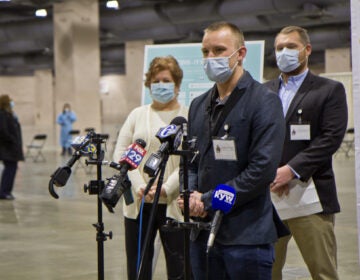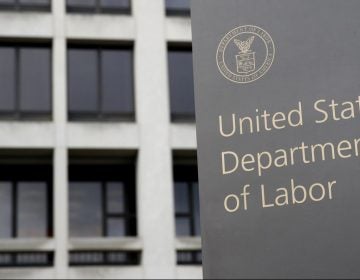Delays and glitches with latest stimulus have slowed relief to Pa.’s unemployed
Some problems stem from a lag between when the first pandemic stimulus funds expired and the time it took to get the second relief package up and running.

A man wearing a face mask to protect against the spread of the coronavirus walks with a dog, Wednesday, Dec. 9, 2020, in Northeast Philadelphia. (AP Photo/Matt Slocum)
Ask us about COVID-19: What questions do you have about the current surge?
The second wave of federal unemployment aid distributed by Pennsylvania has hit some snags.
In online groups and message boards, filers report disappearing claims, irrelevant questions and deadline confusion.
Officials with the Pennsylvania Department of Labor and Industry, which pays out the federal dollars through the state’s unemployment systems, said they are aware of the issues and are working on them.
“Since the reopening of these programs, everything has not gone as smoothly as we wanted,” said Jennifer Berrier, Pennsylvania’s acting secretary of Labor and Industry.
Some problems stem from a lag between when the first pandemic stimulus law, the CARES Act, expired, and the time it took to get the second relief package up and running.
Signed by former President Trump in December, the second significant pandemic relief package extended two programs – Pandemic Unemployment Assistance, PUA, and Pandemic Emergency Unemployment Compensation, PEUC – for an additional 11 weeks.
But it took “several weeks” to get guidance from the federal government on how to dole out those programs, said Berrier. Now, people who are out of work can file for back claims as the 11-week clock ticks.
Initially, some people filing claims for PEUC were not able to file those backdated claims, but that issue is now fixed, Berrier said.
PUA claimants were able to file for the weeks they were out of work before the online portal opened again, but not all have been receiving those funds. The state said it is working to resolve that problem and that claimants do not need to re-file for those weeks.
In some cases, miscommunication fueled online worries. An initial alert from the state told fliers that they had just one week to get all of their claims in. In some cases, applicants also had to wait a week to have their information re-evaluated and approved, stoking fears that they would miss out.
“There might have been a little bit of miscommunication about that Jan. 29 deadline,” Berrier said. “Individuals will still receive those previous weeks [of pay].”
There has also been an error related to proving an applicant’s immigration status. In some cases, applicants are told they must prove they are legally able to receive PUA, which is only available to some work-authorized immigrants and U.S. citizens, before receiving funds.
Some claimants born in the U.S. report they’re now being asked to prove it.
“That’s one of the areas we’re experiencing an error,” Berrier said. Those filers may have wrongly identified themselves as permanent residents, which legally means someone with a green card. State officials recommend in that case, claimants upload a birth certificate or passport to fix that problem.
Even with these glitches, the state reported hundreds of thousands of claims pouring in since they reopened the portal, many successfully processed. Since Jan. 24, the department has issued nearly 115,000 payments through the reopened PEUC program, and 180,000 people have applied for PUA, according to Berrier.

Get daily updates from WHYY News!
WHYY is your source for fact-based, in-depth journalism and information. As a nonprofit organization, we rely on financial support from readers like you. Please give today.




![CoronavirusPandemic_1024x512[1]](https://whyy.org/wp-content/uploads/2020/03/CoronavirusPandemic_1024x5121-300x150.jpg)


